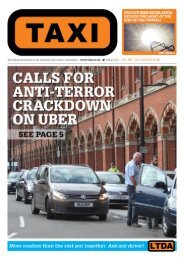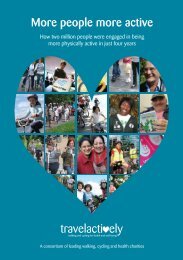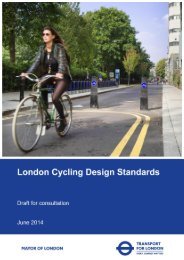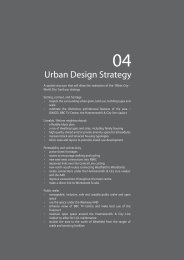Travel in London Travel in London
travel-in-london-report-8
travel-in-london-report-8
You also want an ePaper? Increase the reach of your titles
YUMPU automatically turns print PDFs into web optimized ePapers that Google loves.
3. <strong>Travel</strong> trends by mode<br />
and 3.1 per cent on <strong>London</strong> Overground, while Traml<strong>in</strong>k saw a decrease of 1.5<br />
per cent.<br />
• Patronage of National Rail services serv<strong>in</strong>g <strong>London</strong> (<strong>London</strong> and South East<br />
Operators) cont<strong>in</strong>ued to grow strongly, with a 4.3 per cent <strong>in</strong>crease <strong>in</strong> journey<br />
stages over the latest year. Journeys on National Rail totalled 1,155 million <strong>in</strong><br />
2014/15, an <strong>in</strong>crease of 35.2 per cent s<strong>in</strong>ce 2008, despite the economic<br />
recession, equivalent to 5.2 per cent per year.<br />
• Levels of road traffic <strong>in</strong> <strong>London</strong> have fallen for most of the last decade, but<br />
have shown signs of <strong>in</strong>creas<strong>in</strong>g aga<strong>in</strong> over the most recent two years. Tak<strong>in</strong>g the<br />
period from 2008 to 2014, the net aggregate decl<strong>in</strong>e has been 7.5 per cent <strong>in</strong><br />
central <strong>London</strong>, 9.3 per cent <strong>in</strong> <strong>in</strong>ner <strong>London</strong>, and 0.4 per cent <strong>in</strong> outer <strong>London</strong>,<br />
equat<strong>in</strong>g to an overall reduction of 3.1 per cent at the Greater <strong>London</strong> level.<br />
• This fall <strong>in</strong> road traffic has been attributed to a much-improved public transport<br />
offer<strong>in</strong>g, various wider societal changes affect<strong>in</strong>g car ownership and use, and<br />
reductions to available road network capacity. However, over the most recent<br />
year traffic volumes have started to <strong>in</strong>crease – by 3.4 per cent <strong>in</strong> central<br />
<strong>London</strong>, 1.4 per cent <strong>in</strong> <strong>in</strong>ner <strong>London</strong>, and 1.9 per cent <strong>in</strong> outer <strong>London</strong> (1.8 per<br />
cent at the Greater <strong>London</strong> level). This reversal of trend is thought ma<strong>in</strong>ly to<br />
reflect particularly rapid population growth and recovery from the recession, but<br />
it takes place <strong>in</strong> the context of a cont<strong>in</strong>ued net shift <strong>in</strong> mode share away from<br />
the private car. This comb<strong>in</strong>es with <strong>in</strong>creas<strong>in</strong>g reallocation of available road<br />
network capacity to support a range of other MTS priorities, as well as <strong>in</strong>creased<br />
general construction activity affect<strong>in</strong>g the road network, lead<strong>in</strong>g to further<br />
renewed congestion pressures.<br />
• Cycl<strong>in</strong>g levels <strong>in</strong>creased by 10.3 per cent between 2013 and 2014 – a much<br />
stronger rate of growth than has been typical over recent years. The net growth<br />
s<strong>in</strong>ce 2008 <strong>in</strong> terms of journey stages has been 31.9 per cent, equivalent to 4.7<br />
per cent per year on average.<br />
• Some 6.4 million walk-all-the-way trips were made on an average day <strong>in</strong><br />
<strong>London</strong> <strong>in</strong> 2014. This is an <strong>in</strong>crease of 9.3 per cent s<strong>in</strong>ce 2008, and ma<strong>in</strong>ly<br />
reflects population growth over the period (which was also 9.3 per cent). This<br />
gives a walk<strong>in</strong>g mode share (for all travel) of 24 per cent, which is identical to the<br />
position <strong>in</strong> 2008. However, there is evidence that <strong>in</strong>creased public transport use<br />
has, as a by-product, <strong>in</strong>creased the number of walk journey stages undertaken<br />
by <strong>London</strong>ers, with associated health benefits.<br />
• Trends for the amount of freight traffic on <strong>London</strong>’s roads have particularly<br />
mirrored the fortunes of the wider economy. Van traffic <strong>in</strong> <strong>London</strong> <strong>in</strong>creased by<br />
3.4 per cent <strong>in</strong> aggregate between 2008 and 2014, driven by an 8.3 per cent<br />
<strong>in</strong>crease <strong>in</strong> outer <strong>London</strong>, although there were decl<strong>in</strong>es <strong>in</strong> central and <strong>in</strong>ner<br />
<strong>London</strong> of 4.9 and 6.0 per cent respectively over the same period. However,<br />
this masks the effects of the recession. Between 2008 and 2011, van traffic<br />
decl<strong>in</strong>ed by 6.1 per cent, but has been grow<strong>in</strong>g strongly s<strong>in</strong>ce then, with van<br />
traffic <strong>in</strong> 2014 10.1 per cent higher than <strong>in</strong> 2011.<br />
• Heavy goods vehicle traffic decl<strong>in</strong>ed by 3.2 per cent between 2008 and 2014,<br />
with falls of 8.0 per cent <strong>in</strong> <strong>in</strong>ner <strong>London</strong> and 1.9 per cent <strong>in</strong> outer <strong>London</strong>,<br />
although there was a 2.7 per cent <strong>in</strong>crease <strong>in</strong> central <strong>London</strong>.<br />
• TfL’s River Services have seen significant expansion, with passenger traffic on<br />
the Thames <strong>in</strong>creas<strong>in</strong>g by 19.1 per cent <strong>in</strong> the latest year.<br />
50 <strong>Travel</strong> <strong>in</strong> <strong>London</strong>, Report 8








